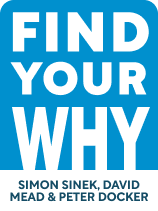

This article is an excerpt from the Shortform book guide to "Find Your Why" by Simon Sinek, David Mead, Peter Docker. Shortform has the world's best summaries and analyses of books you should be reading.
Like this article? Sign up for a free trial here .
What is the definition of a purpose-driven organization? How can leaders create purpose-driven organizations?
Author Simon Sinek co-wrote Find Your Why with David Mead and Peter Docker: a book that lays out a step-by-step process for discovering purpose. According to Sinek, a purpose-driven organization is more successful and contributes more to the world.
Read on to learn why purpose matters in organizations and advice for leading a purposeful organization, according to Sinek.
Purpose-Driven Organizations
Sinek argues that finding your Why or purpose can help you make better choices in your work and your life that lead to greater fulfillment. That’s what he found in his own life after struggling with depression until he identified his purpose: “To inspire people to do what inspires them so that, together, we can change our world for the better.” He then began to help others find their purpose, most famously through his popular 2009 TED Talk and by working directly with individuals and organizations.
Besides coaching and giving talks, Sinek shared his ideas about the centrality of purpose through his bestselling book, Start With Why, also published in 2009. In that book, he outlined his theory that the most successful organizations are the ones that have a clear purpose and stick to it as they grow.
At the center of Sinek’s theory is a model he uses to illustrate the connection between your Why (purpose), your How (methods and practices), and your What (actions and outcomes). After several years of working directly with some organizations, Sinek realized that to achieve his purpose, he needed to broaden his impact. To provide practical help to more people, he co-wrote Find Your Why with David Mead and Peter Docker: a follow-up book that lays out a step-by-step process for discovering your purpose that individuals and organizations can follow.
Lead With Your Purpose
Sinek says creating a purpose-driven organization means sharing the purpose when talking to customers, clients, suppliers, etc., because by keeping your purpose to yourself, you only let others (for example, customers or potential employers) see your outputs and methods without knowing what’s driving the organization. The connection they make with your organization is surface-level. According to Sinek, this doesn’t foster long-term relationships. Let’s explore why:
Leading with What, or outcomes: You introduce yourself or your organization by talking about your product or service. Some people decide to buy from you, hire you, or join you—but only for as long as you’re the cheapest or most convenient option.
Leading with How, or methods: You introduce yourself or your organization by talking about the unique methods or practices that set you apart from the competition. Some people choose you—until your way of doing things catches on, and you become one of many similar options with the same How.
Leading with Why, or purpose: You introduce yourself or your organization by talking about your mission, the problem you’re trying to solve, or the fundamental belief you have about the future. More people choose a purpose-driven organization because they understand that supporting you means supporting that purpose. Other competitors might offer similar outcomes or methods in the future, and maybe even at more convenient terms, but you will always have the advantage of the emotional connection you forged by involving people in your purpose.
(Shortform note: This concept of leading with your purpose is not new to sales. For example, in To Sell Is Human, Daniel Pink recommends a model based on trust and a genuine interest in serving the customer rather than wanting to take advantage of them. His two rules for service-oriented selling are to make it personal and to make it purposeful. By leading with your Why rather than What or How, you create a purpose-driven organization and focus on what makes you unique, thereby applying Pink’s rules.)
Exercise: Lead With Your Purpose
Sinek recommends leading with your purpose or Why to create stronger connections and be more persuasive.
- Write down how you’d usually introduce yourself or your organization.
- Consider your previous response. Do you lead with your Why, How, or What (purpose, methods, or results)? How do you think this helps or harms your long-term relationships?
- Rewrite how you might introduce yourself or your organization so the focus is on your Why.
| Purpose-Driven Organizations: Additional Advice In The Culture Code, Daniel Coyle outlines ways leaders can develop purpose in the workplace that complement the steps in Find Your Why: – Communicate priorities to empower team members. When leaders clearly communicate the purpose and let everyone know that it’s the top priority, team members are better equipped to make decisions and assess the What, or outcomes. – Incentivize behavior through high and consistent standards. As Sinek suggests, you can do that by praising behavior that aligns with the team’s Why and encouraging members to find their personal purpose so they internalize the importance of being in alignment with their Why. – Use a shared language, like a memorable motto, to remind members of the team’s values and practices. As you refine the purpose statement, take the opportunity to make it catchy enough that team members can use as a motto. |

———End of Preview———
Like what you just read? Read the rest of the world's best book summary and analysis of Simon Sinek, David Mead, Peter Docker's "Find Your Why" at Shortform .
Here's what you'll find in our full Find Your Why summary :
- Simon Sinek’s steps to understanding and living your purpose and your organization’s
- How to create and write your purpose statement
- What to do after you find your Why: Determine your How






